| 1 | Corn snake |
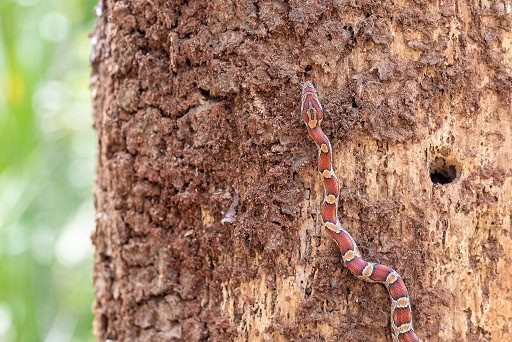
The most popular captive pet snake worldwide, but also a common species in the eastern USA, including Florida, Georgia, Alabama and the Carolinas alike. Wild corn snakes are easily recognisable by their orange-yellow alternating markings.
Though corn snakes are primarily ground-dwelling, branches 3-5 metres high are easily within their reach. The main temptation that draws them skyward is food, as corn snakes love to steal bird chicks directly out of their nests. To accomplish this, the corn snake has a specially modified body to allow effortless climbing of trees. Rather than a rounded belly, a corn snake’s is flat on the bottom, and its chequered belly scales are sharply angled/keeled. This allows them to dig into soft bark on tree trunks, like a mountaineer’s crampons dig into ice.
When descending a tree, corn snakes always move down a tree trunk carefully rather than leaping casually to the Earth, as they’re not feather light like some of the tiniest snakes. They’re epic climbers but not quite immune to the forces of gravity.
Corn snakes naturally live in woodlands and mixed grassy areas with bushes and thickets. They also appear at the edges of buildings or below piles of garbage. They’re an intelligent snake as well, and were found in an experiment to become more adept at escaping a small maze the second time they were placed in it.
| 2 | Chilean green snake |
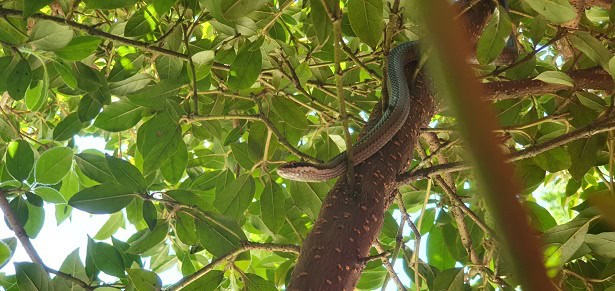
One of the 7 snake species native to Chile, and easily the most common. The Chilean green racer (Philodryas chamissonis) measures up to 220cm and is fast and whippy with a tendency to invade people’s houses.
This snake is great at climbing trees for the simple reason that it can do almost anything. Chilean green racers have only a weak venom, but are agile, can poke their heads into burrows, swallow rats within minutes, and enjoy midnight serenades on rooftops. Trees are just another obstacle, which they brush aside in their endless quest for food and mates. The Chilean green racer has a taste for bird eggs, and trees are the place to get them. They also zip up trees for strategic reasons that aren’t fully researched – it’s possible that they simply like flexing their skills.
A large portion of photos are of this species slithering along a branch and looking confident. Chilean green racers are also common on the ground, and are a common species in populous towns of Chile. They’re incapable of causing death, but can’t stand it when humans get in their way, and rapidly turn vicious. Chilean green racers swill slither up a tree without hesitation, with no concern over the consequences if they fall out at an unfortunate angle.
| 3 | Grey ratsnake |
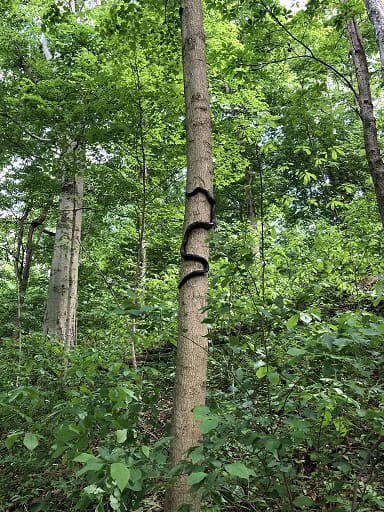
Have you ever been exploring a US woodland, looked up and seen the exact sight in the image above? It was almost certainly a Pantherophis ratsnake member, as these are easily the best tree climbers the US has to offer, and the most likely to be seen ascending vertical trunks. There’s also a chance of it being the corn snake, but they’re easier to recognise with their red-yellow colours.
Grey ratsnakes (Pantherophis spiloides) live in states immediately east of the Mississippi river, whereas eastern ratsnakes (Pantheraophis alleghanesis) take over along the east coast. For example, the Florida panhandle is home to grey ratsnakes, while peninsular areas host eastern ratsnakes. Both species are top bird’s nest raiders, feeding on the likes of northern mockingbirds, house finches, blue jays, and red junglefowl. Scents lure them on to these species, and most likely retained knowledge of trees where birds have previously constructed nests.
To grab these, the grey ratsnake must learn the fine art of slithering up a tree trunk vertically with no comfortable ledges, and that’s what they’ve done. Over millions of years, an initial taste for birds has pushed them ever further down the effortless tree climbing route, sharpening their skills, to the point where their tree-climbing skills outstrip the local rattlesnakes 100-fold. If a small grey ratsnake wanted to escape an eastern indigo snake (a top snake predator), all it would have to do is slither upwards, leaving the flummoxed indigo snake stuck at the bottom.
Grey ratsnakes are non-venomous constrictors, which reach a maximum of 214cm. Admire this snake from a distance, as they’re prone to sudden mood swings and may unleash an aggressive assault.
| 4 | Rhombic cat-eyed snake |
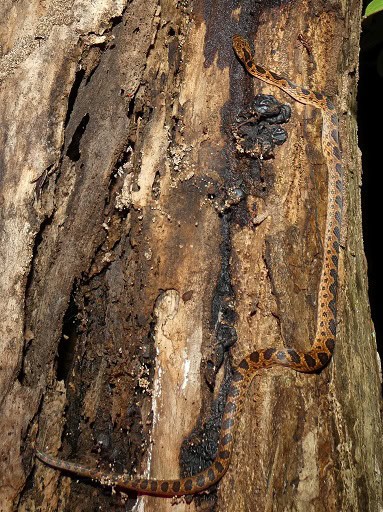
The rhombic cat-eyed snake lives in central America from Guatemala to Panama, where it lives side by side with neurotoxic coral snakes. The latter live only in 2d – they can go forward, left or right, but never up. The rhombic cat-eyed snake lives in a 3d world instead, being such an effortless climber that it can ascend trees whenever it wants.
This is a mildly venomous snake which can unleash stinging and swelling in humans, and reaches a maximum of 1 metre. They’re part of the 18-member Leptodeira family, also including the annulated cat-eyed snake of Brazil. All of these are excellent tree climbers, and the rhombic cat-eyed snake (Leptodeira rhobifera) is so skillful that it hasn’t occurred to them that climbing trees could ever be difficult. Whether it’s a series of diagonal branches that form a convenient stairway, or a completely vertical tree trunk like in the image above, it doesn’t matter to this snake. Few treetops are beyond their reach.
Rhombic cat-eyed snakes have innate climbing instincts, but also a thin body that allows them to curl around branches like spaghetti. This species is particularly common in Panama City and its outskirts.
| 5 | White-lipped pitviper |
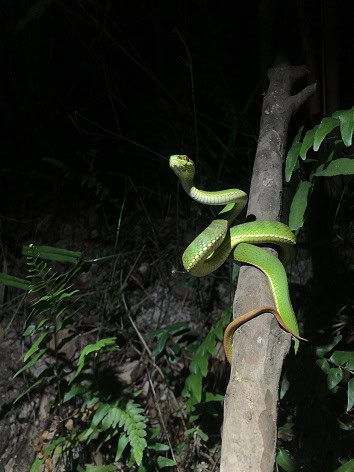
According to one study, white-lipped pitvipers cause 95% of venomous snakebites in Hong Kong, and they similarly dominate the statistics for Bangkok. This is a widespread species of southeast Asia which is found in every corner of Thailand, and is the most common of the 40-member Trimeresurus green pitviper clan.
White-lipped pitvipers reach a maximum of 81cm, with females being longer. They’re a completely arboreal snake – they spend virtually all their lives on trees or in bushes. While they can ascend higher, branches 1-3 metres high are their favourite position, explaining why bites to the arms are more common than legs. It’s no good dedicating yourself to life on branches if you can’t even climb trees. All the other pitvipers would be laughing at you as you stumble and slide back down again, but Trimereus albolabris ascends tree branches effortlessly, as the image above shows. It wraps around them to seal its position with a couple of coils, which it performs instinctively.
White-lipped pitvipers can ascend thin, spindly branches and thick trunks to equal effect. This species appears in forests, but is just as common in towns and suburbs, including Thai people’s backgardens (be careful).
| 6 | Central American tree snake |
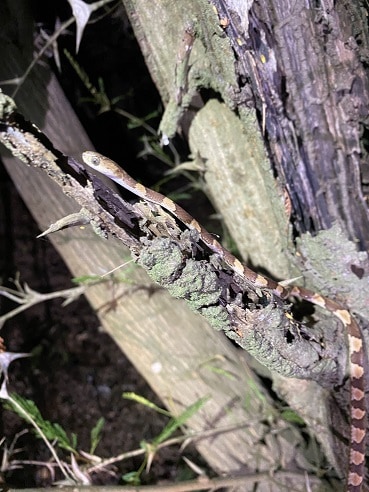
This Honduran snake requires only the flimsiest of branches to soar metres into the air. The Central American tree snake (Imantodes gemmistratus) is a constrictor which reaches a maximum of 93cm, and poses little threat to humans. This species is found from northern Mexico through the whole of Central America, to its final stopping point in Columbia.
Across that territory, Imantodes gemmistratus is one of the most consistent tree-dwelling (arboreal) snakes. They primarily hunt reptiles such as Anolis lizards, and this hunting takes place in a confusing world of overlapping leaves, swaying branches and hidden hollows in tree trunks. Imantodes gemmistratus is especially reliant on eyesight for hunting, spotting subtle moving details in the canopies, which are actually anoles or skinks on a distant branch. Then they have to plot a course through the complex maze of the canopies to reach that branch.
To achieve these goals, they have to reach the higher branches in the first place. Imantodes gemmistratus charge up trees so fast that it’s like they’re escaping the jaws of a crocodile. In reality, this is their natural moving speed, and a 5 metre high tree is the flimsiest possible barrier to them.
Millions of years have passed during which this species has been continuously moulded by the forest, allowing it to cross between trees, to blend into trees, and finally, to effortlessly climb them. This is part of the 7-member Imantodes family, the most common member being the blunt-headed tree snake, which is famous for its huge eyes.
| 7 | Southern twig snake |
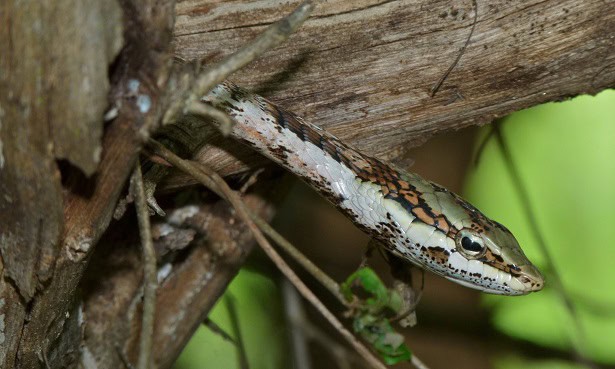
One of the ultimate snakes when it comes to mimicking a tree branch and achieving ultimate camouflage. The southern twig snake (Thelotornis capensis) inhabits southeastern Africa, including eastern South Africa, Botswana, Zimbabwe and Mozambique, reaching as far north as Tanzania. Thelotornis capensis is moderately venomous, with one 6 year old boy suffering from nausea and totally uncoagulable blood that led to prolonged bleeding (he survived).
Another of their skills is effortless tree climbing. Trees and bushes are the main sanctuary of this 80-120cm snake, and consequently, they’re able to ascend them extremely rapidly, disappearing into their sanctuary in the nick of time. The southern twig snake can ascend a tree trunk vertically, and loses no speed. They don’t stop to consider, they just keep going. The reason is that they don’t have to. The southern twig snake is fully built and fully optimised for tree climbing – their only potential foil is being struck by lightning halfway up.
The southern twig snake rarely bites humans unless provoked, but has sent a few victims to hospital. They have an intimidating glare, combining with their sharply keeled scales to heighten the menace. This is a reptile-hunter which is most active during daytime, and belongs to the 4-member Thelotornis family. Though their camouflage is amazing, they have to actually be in a tree for it to work. In a grassy field nearby, they’d be badly exposed, and a watchful bird might cock its head from afar.
| 8 | Paradise flying snake |
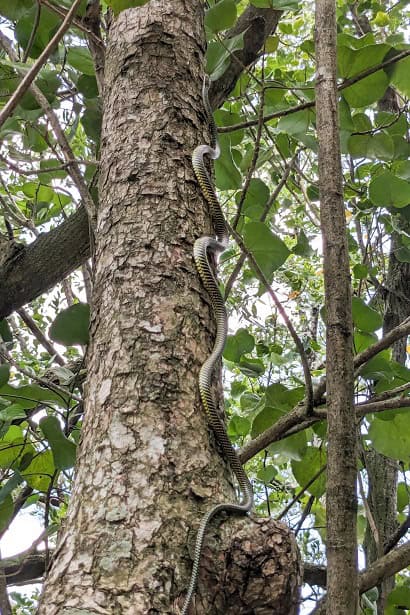
This arboreal species measures 90cm and mainly inhabits southern Thailand, Malaysia and Singapore. This is a mildly venomous species, which preys primarily on lizards and geckos. While the paradise flying snake is unable to drive a car, or run a multi-national corporation, they have several advantages over humans: 1) the ability to glide nearly 100 metres after leaping from a tree, and 2) the ability to climb near vertical tree trunks.
Paradise flying snakes are fairly abundant in their southeast Asian realms, and the way to find them is nearly always to look up rather than down into a burrow.
With the paradise flying snake, ascending inaccessible tree trunks is essential for their very survival, as it allows them higher positions to leap from when ambushing their prey. They hunt geckos by spotting them on distant tree branches, reaching the closest point they can, then making the fateful leap.
Paradise flying snakes become airborne by morphing their body shape, elongating themselves sideways to create an air pocket underneath. They have a thin body, allowing them to reach 15-20 metres high up trees without snapping delicate branches. This species is actually a superior flier to the more famous golden flying snake, which is most common in central Thailand.
| 9 | Central American eyelash viper |
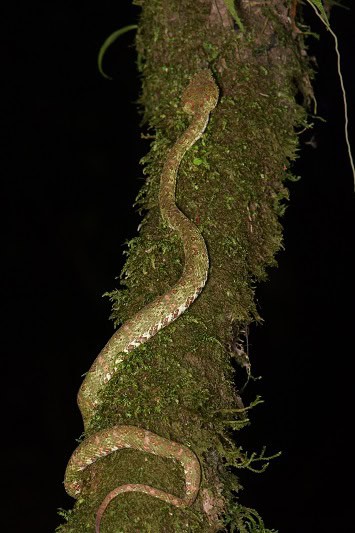
Not the fastest tree climber, but one which grinds steadily upwards with not an ounce of fear. This pitviper lives all over Central America, except for El Salvador, and spends 60-70% of its time in trees. The Central American eyelash viper is highly venomous and relies on ambush tactics, clinging menacingly to branches for hours. They’re spotted most commonly in national parks, on the edges of popular trails, with large populations lurking deeper in the forests that nobody ever sees.
Central American eyelash vipers are cautious and slow, choosing the optimal tree, slithering up and beginning a long watch. Being a great tree climber is out of necessity, as their entire strategy would be defeated otherwise. This species attacks humans sometimes, but bites aren’t a total epidemic like with the fer-de-lance. They do appear in banana plantations however, where certain morphs have yellow colours and blend in expertly. Others like above are green-mossy and blend perfectly with rainforest tree trunks.
Eyelash vipers have the power to attack you from a branch, striking the chest rather than ankles or shins. They also have the power to attack you from a fruit box. By lurking in banana trees, eyelash vipers are sometimes wrapped up in crates and shipped thousands of miles overseas.
| 10 | Common bronzeback (India) |
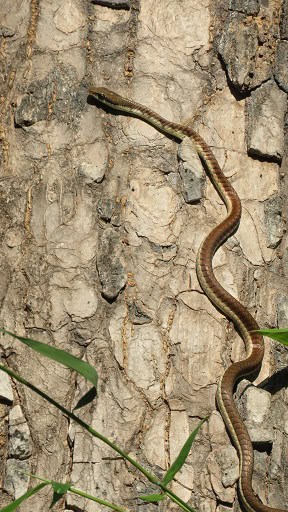
Snakes of the effortless tree-climbing crew can be short or long, with the western mangrove catsnake reaching 2 metres. Length matters little. The main quality is a thin body relative to that length. The common bronzeback, for example, reaches a maximum length of 169cm, yet is barely wider than a hosepipe.
This species lives across virtually of India, except the dry northwest. Though they lack venom and are vulnerable to birds, they’re excellent at slithering directly up trees, bypassing gravity. Common bronzebacks can ignore the trunk altogether and zip right up thin, spidery branches stroking the ground.
Common bronzebacks live in fully-fledged forests, but also appear along the forest edges, and isolated tree clumps near villages. They lack even a mild venom, and stay balanced by curling their body securely around the branch. Their eyes are large, and they’re recognisable by a body split clearly between a pale underbelly and a darker brown back.
Some thick-bodied snakes climb trees, but only very tentatively, and to the lowest branches. If a blood python climbed 5 metres high, the branch would snap, sending it plummeting to the Earth with only seconds to think its last thoughts. Luckily, the same isn’t true for this harmless Indian creature.
